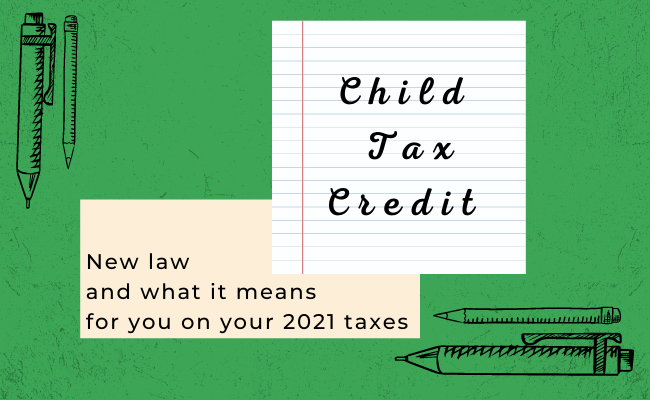ARPA Changes the Child Tax Credit by giving you more Money – (2021 Only)
For 2021 only, the new American Rescue Plan Act (ARPA) makes big, taxpayer-friendly changes to the federal income tax child tax credit (CTC).
Here’s what you need to know, starting with some necessary background information.
CTC Basics
For 2018-2020 and 2022-2025, the maximum annual CTC is $2,000 per qualifying child.
A qualifying child is under-age-17 who could be claimed as your dependent for the year.
Basically, that means:
- The child lived with you for more than half the year
- Did not provide more than half of his or her own support
- Is a U.S. citizen, U.S. national, or U.S. resident
The CTC has a cap of $200K for single and $400k for married filing jointly. After you have reached that income level, (first, yay for you!) the credit amount begins to decline. The way the IRS see it is you make enough money to not need the credit. Don’t shoot the messenger!
You can collect the refundable amount even if you have no federal income tax liability for the year. So, the refundable amount is free money.
More Generous CTC Rules for 2021
For your 2021 tax year only, ARPA makes the following taxpayer-friendly changes.
Qualifying Children Can Be Up to 17 Years Old. (Basically you can count your child for 1 more year.)
The definition of a qualifying child is broadened to include children who are age 17 or younger as of December 31, 2021.
Bigger Maximum CTC with Separate Phaseout Rule for the Increase
ARPA increased the maximum CTC to $3,000 per qualifying child, or $3,600 for a qualifying child age 5 or younger as of December 31, 2021. This of course comes with stipulations, just similar to the 2020 version.
The increased CTC amount ($1,000 or $1,600) phase out amount and rules are:
- Single taxpayers with MAGI above $75,000,
- Heads of household with MAGI above $112,500,
- Married joint filing couples with MAGI above $150,000.
Something of note: The increased amount is phased out by $50 per $1,000 (or fraction of $1,000) of MAGI in excess of the applicable phaseout threshold. The “regular” $2,000 CTC amount is subject to the “regular” phaseout rule explained earlier. (in other words, the increase CTC amount has a different phase out rate than the regulars CTC)
For those who make more than then the new caps: you can still claim the regular CTC of up to $2,000, subject to the regular phaseout rule.
CTC Is Fully Refundable for Most Folks
The CTC is fully refundable if you have a principal residence in the U.S. for more than half the year.
Are a member of the U.S. Armed Forces who is stationed outside the U.S. while serving on extended active duty. You’re treated as having a principal residence in the U.S.
For 2021, the CTC is fully refundable even if you have no earned income for the year.
IRS Will Make Advance CTC Payments (fingers crossed)
We all have to give the IRS some breathing room. Even though for most of us, the only time we like the IRS is when we are getting that refund check, they have had one crazy tax season. Between all of the tax law changes this previous tax, they are going the best they can. (Talk about earning you paycheck!) Here is another ARPA provision that directs the IRS to establish a program to make monthly advance payments of CTCs (generally via direct deposits).

Wait the IRS is going to be cutting monthly checks? Don’t hold your breath if it does happen it will be for the last half of the year.
Such advance payments will equal 50 percent of the IRS’s estimate of your allowable CTC for 2021. These payments will be made in the equal monthly installments.
To estimate your advance CTC payments, the IRS will look at the information shown on your 2020 Form 1040 (or on your 2019 return if you have not yet filed your 2020 return). It will be in your best interest to file your 2020 taxes!
Here is what you should hold you breath for, its up tot he IRS to make the payment structure decision. Not to say they money will not go out, it just may not be feasible to cut monthly checks. If that happens the money will be distributed is some other undecided form. Its one of those cross that bridge if we need to.
Can an Overpayment Happen?
In the case that you receive advance CTC payments in excess of your allowable CTC for the 2021 tax year, you’ll generally have to repay the excess in the form of an increase in the federal income tax liability shown on your 2021 Form 1040. Since, this is an estimate based on the previous year’s tax filings the IRS doesn’t have a crystal ball to send out the right amount.
Something of note: To assist in this program, the IRS is supposed to create an online portal that will allow taxpayers to change the number of their qualifying children, change their marital status, reflect significant changes in income, and update other factors as determined by the IRS.
(Assuming this task is not farmed out to the Small Business Administration, the portal might actually work. Fingers crossed!)
Child ID Requirements
As was the case before ARPA, you must include a qualifying child’s name and Social Security number (SSN) on your 2021 Form 1040 to claim a CTC for the child.
The SSN must have been issued before the due date for filing your 2021 return. If you can’t meet these ID requirements for a qualifying child, you can claim the smaller $500 credit explained below.
Smaller $500 Credit
For 2018-2025, you can claim a $500 nonrefundable credit for a dependent who does not meet the definition of a qualifying child.
For 2021, the most common situation when this smaller credit will be available is when you have a dependent child who will be age 18 or older as of December 31, 2021. But you can also claim the smaller credit for other qualifying relatives, as defined. The MAGI phaseout rule for this smaller credit is the same as the regular CTC phaseout rule explained at the beginning of this article.







